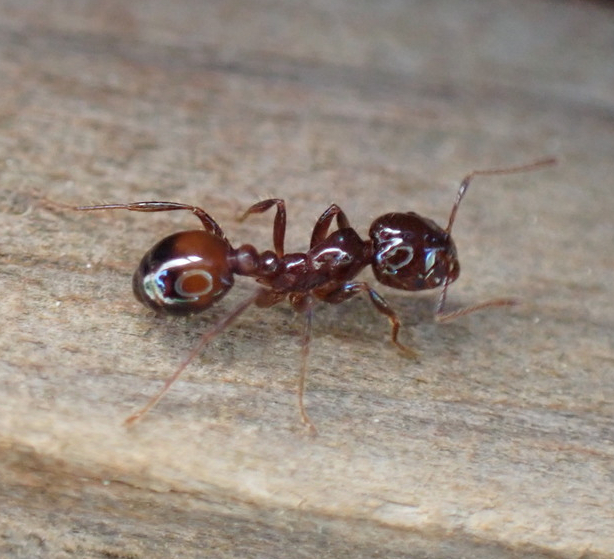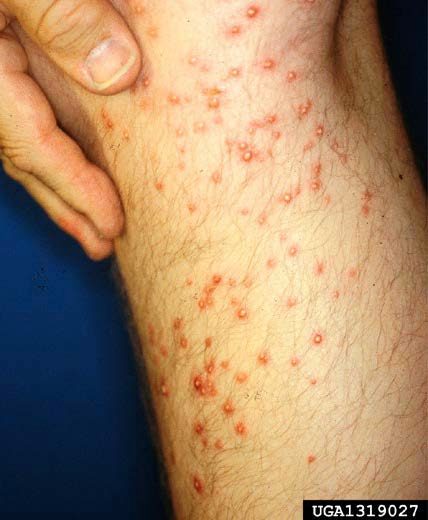Hybrid fire ants turn up the heat in far Southwest Virginia
Virginia Tech entomologists have partnered with Virginia Cooperative Extension to help track and prevent the spread of hybrid fire ants in the commonwealth.

In Lee County, Virginia Cooperative Extension Agent Amy Byington is working to stop a tiny invader posing a big problem.
Hybrid fire ants, which are well-established across East Tennessee and parts of Kentucky and North Carolina, are now infiltrating far Southwest Virginia.
“It’s just one more nuisance,” said Byington, who leads efforts in her county to report and treat the growing issue. “I get calls every week from landowners who are discovering new ant mounds on their property.”
Byington partners with the Virginia Department of Agriculture and Consumer Services (VDACS) to locate and treat the mounds with insecticide bait.
“One of my producers recently reached out and reported they had found six fire ant mounds on their farm,” she said. “The VDACS inspector later ended up counting 58. It’s a management issue and a human issue.”
As of 2024, Lee County is the only county in Virginia with a presence of hybrid fire ants, although this is expected to change in coming years as ants gradually expand their territory north and east.
Fire ants on the march
Fire ants are common in southern states, mainly due to warmer climate conditions. Imported red and black fire ants first appeared in Virginia in the early 2000s, near the North Carolina border. Virginia’s increasingly warmer climate, with milder winters and hotter summers, has created more favorable conditions for fire ants to thrive and reproduce. As temperatures rise and winters become less severe, these ants are expanding their range farther north into the state.
Hybridized fire ants are the result of interbreeding between the red imported fire ant and the black imported fire ant, resulting in a more aggressive and resilient species.
Scotty Yang, assistant professor in the Virginia Tech Department of Entomology within the College of Agriculture and Life Sciences, said hybrid fire ants have developed a “superpower” that allows them to thrive in in Virginia.
“When two different species interbreed, they can ‘borrow’ genes from one another,” he said. “If those borrowed genes happen to be useful – say, for surviving cold winters – they may stick around and give the hybrid a leg up in adapting to its environment. It is likely the hybrid gets the best of both worlds from its parents, combining traits that allow it to thrive in colder environments such as Southwest Virginia.”
How do hybrid fire ants spread?
Hybrid fire ants can be transported and spread via bales of hay, vehicles, trailers, farm equipment, or firewood. The Virginia Department of Agriculture and Consumer Services and the U.S. Department of Agriculture have set up state and federal fire ant quarantines in southeastern Virginia, where the red imported fire ant is prevalent, but this quarantine has yet to expand to Lee County or any areas in Southwest Virginia. According to Yang, the ants' current spread has “far outpaced past predictions.”
“They’re advancing much faster than anticipated,” he said. “While it’s hard to say exactly when fire ants will establish themselves permanently in the New River Valley or Roanoke, given this rapid movement, it could happen as soon as the next few years.”
In the aftermath of damage suffered from Hurricane Helene in late September, diligent inspection of hay for fire ants has been more important than ever. Byington heads up the Southwest Virginia Agriculture Relief Program, distributing donated hay to farmers in need.

What are the dangers of hybrid fire ants?
Hybrid fire ants are extremely aggressive and tend to swarm when their mound has been disturbed. Pheromones released by the ants quickly alert colony members to the threat, leading to a mass attack and many stings by the defending ants. The effects of stings are similar to that of a bee sting and anaphylactic shock is possible in sensitive individuals.
“People need to be educated on these ants so they can prepare,” Byington said. “They are dangerous for populations not used to dealing with them and who initially treat them like normal ants.”
If you happen to get stung and experience whole body reactions, such as hives, shortness of breath, or swelling, seek medical attention. Virginia Cooperative Extension’s publication "Avoiding Fire Ant Stings" is a helpful resource for homeowners and farmers in educating themselves on potential dangers and treatments.
Eric Day, head of the Insect Identification Lab in the Department of Entomology, has seen firsthand the damage fire ants can cause to livestock and small animals. On a visit to an infested farm in East Tennessee, a farmer reported a newborn calf death in close proximity to multiple fire ant mounds.
“Fire ants have been known to kill calves, although there may have been another factor in its death,” said Day.
How do I identify and treat a fire ant mound?
Aggressive, swarming behavior is often a key indicator of fire ants. Mound size varies, and can range from almost flat to 18 to 24 inches tall. These mounds are often found in open, sunny areas, and clay soils tend to produce taller mounds than sandy soil.
Unlike other species of fire ants, hybrid fire ants are tolerant of nearby colonies, meaning many mounds can be found in a small area. Caution should be used when attempting to eradicate the ants, and home remedies such as setting fire or pouring gasoline on the mounds are strongly discouraged.
For the most effective treatment, Byington recommends sending in an ant sample to your local Cooperative Extension office for free testing or contacting VDACS at 804-786- 3515.
“I am constantly collecting samples that are sent off to Virginia Tech’s insect identification lab, and I am someone local that the landowners can reach back out to if needed to act as a conduit between citizens and VDACS during treatment,” Byington said.

How has Virginia Cooperative Extension contributed to research and outreach?
Yang said collaboration with Virginia Cooperative Extension and agents like Byington has been a “game-changer” for his research.
“It gives me a clearer picture of where hybrid fire ants are popping up locally and provides access to valuable samples for genetic analysis,” he said. “These samples help us understand their dispersal patterns, which is essential for predicting where they might go next.”
Yang also said Extension bridges the gap between research and the real-world challenges faced by farmers, landowners, and other stakeholders.
“One of my current projects focuses on improving fire ant baiting systems by boosting their foraging efficiency,” he said. “Thanks to Virginia Cooperative Extension, I can share my findings, speak directly with stakeholders, and even recruit participants for field trials. Extension plays a vital role in connecting science to the people who need it most.”
For further reading and information, visit Virginia Cooperative Extension’s publication on "Hybrid Fire Ants in Virginia," authored in part by Byington and Day.


